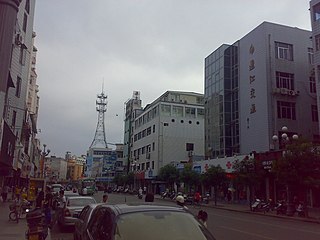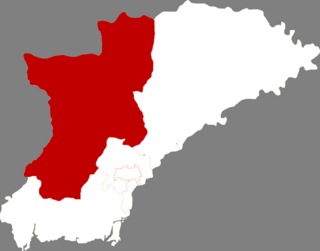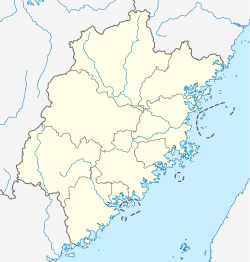
Lianjiang is a suburban county of Fuzhou on the eastern coast of Fujian province, People's Republic of China. Most of the county is controlled by the People's Republic of China (PRC), while a number of outlying islands, collectively referred to as the Matsu Islands, are administered as a separate Lienchiang County by the Republic of China (ROC), based in Taiwan since 1949. As a result, the county has two governments governing separate jurisdictions.

Yongding is a district under the jurisdiction of Longyan prefecture-level city in the southwest of Fujian Province, People's Republic of China. It is the home of many Hakka-speaking families. Yongding has a population of about 400,000, of which more than 99% are Hakka, the rest being Southern Min-speaking people. It was reported at the end of 2014 that Yongding had become a district, having previously been a county.
Fengcheng is the pinyin romanization of various Chinese placenames. It may refer to:

Yichun (Chinese: 宜春; pinyin: Yíchūn; Wade–Giles: I2-ch'un1; postal: Ichun) is a mountainous prefecture-level city in western/northwestern Jiangxi Province, China, bordering Hunan to the west. Yichun literally means "pleasant spring". It is located in the northwest of the province along a river surrounded by mountains. Yichun has a history of over 2,200 years. It was established in 201 BC during the Han Dynasty. Yichun has a profound Buddhist culture. "Can Lin Qing Gui", the monastic rules for Buddhists at the Buddhist temple, originated from Yichun. Yichun is also the birthplace of a number of literary figures, such as Tao Yuanming and Deng Gu, both of whom are poets from ancient times.

Anxi County (help·info) is a county of the municipal region of Quanzhou, in southern Fujian province, People's Republic of China. It lies adjacent to and directly north of Xiamen.

Fengcheng is a county-level city in northern Jiangxi province, People's Republic of China, under the administration of Yichun, located along China National Highway 105 and on the eastern (right) bank of the Gan River about 55 kilometres (34 mi) south of Nanchang, the provincial capital. The literal translation of the name is "Abundance City", due to its importance as a major commercial hub for agricultural products. There are 26 towns and 7 sub-districts comprising a total area of 2,845 square kilometres (1,098 sq mi) and its population is around 1,370,000. The 2005 GDP was more than 9.1 billion RMB.

Rongcheng is a county in central Hebei province, China. It is under the jurisdiction of Baoding prefecture-level city. The area of the county is 311 km2 (120 sq mi), while the county seat is located in Rongcheng Town.
Fuzhou is the capital city in Fujian, China.

Qingcheng is a district of Qingyuan, Guangdong province, China.

Lincheng County is a county in the southwest of Hebei province, People's Republic of China, in the foothills of the Taihang Mountains. It is under the administration of the prefecture-level city of Xingtai. In 2010, its population was 204,000 and lived in an area of 797 km2 (308 sq mi). It borders Neiqiu in the south, Longyao and Baixiang in the east, Gaoyi and Zanhuang in the north, and the province of Shanxi in the west.

Kuandian Manchu Autonomous County, is a county of eastern Liaoning province, China, bordering North Korea to the southeast and Jilin in the northeast. It is under the administration of Dandong City, the centre of which lies 75 kilometres (47 mi) to the southwest, and is served by China National Highway 201. In Kuandian is the Hushan Great Wall, the most easterly section of the Great Wall of China. A short reconstruction of the wall is open to tourists. The area has an abandoned airstrip that was used by the Chinese airforce during the Korean War.

Fengcheng is a city in the southeast of Liaoning Province in Northeast China. Administratively, it is a county-level city under the administration of Dandong, the downtown of which lies 45 kilometres (28 mi) southeast of the city.

Fengcheng Subdistrict is a Subdistrict in Changshou District, Chongqing, People's Republic of China.

Huage Town is an urban town in Nan County, Yiyang, Hunan Province, People's Republic of China.
The Fengcheng Reservoir is a reservoir on the Irtysh–Karamay Canal in China's Xinjiang Uighur Autonomous Region. It is about 15 km north of the main urban area of Urho District of Karamay City;
administratively, the location is near the border of Urho District and Hoboksar Mongol Autonomous County.

Fengcheng 5-lu station, is a station of Line 2 of the Xi'an Metro. It started operations on 16 September 2011.

Daxing is a town under the administration of Fengcheng, Liaoning, China. As of 2018, it has 6 villages under its administration.















